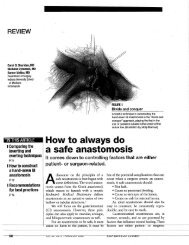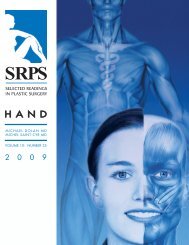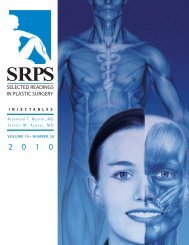Craniofacial Anomalies, Part 2 - Plastic Surgery Internal
Craniofacial Anomalies, Part 2 - Plastic Surgery Internal
Craniofacial Anomalies, Part 2 - Plastic Surgery Internal
You also want an ePaper? Increase the reach of your titles
YUMPU automatically turns print PDFs into web optimized ePapers that Google loves.
Relative indications for decompression are<br />
• patients presenting within 2–3 weeks of rapid visual<br />
loss<br />
• children or adolescents with no visual loss but<br />
radiographic evidence of optic canal reduction,<br />
since they are likely to have progressive growth of<br />
fibrous dysplasia<br />
• patients with no visual loss who have radiographic<br />
evidence of optic canal reduction and continuing,<br />
active fibrous dysplasia.<br />
Reconstruction after resection is typically immediate.<br />
Edgerton and colleagues336 described the use of<br />
the dysplastic bone as grafts, which following resection<br />
were contoured, thinned, and replaced. These<br />
grafts of dysplastic bone seem to function similarly to<br />
normal autogenous grafts and lack the potential for<br />
gradual recurrence of bone thickening frequently seen<br />
with in situ bone contouring. Autoclaving350 and cryotherapy351,352<br />
have been proposed to destroy the cellular<br />
elements and yet preserve the mineral matrix<br />
prior to reinsertion.<br />
Chen and Noordhoff353 analyzed their experience<br />
with the treatment of 28 patients with fibrous dysplasia.<br />
The authors outline a protocol for surgery (Table<br />
6) that includes<br />
1. total excision of dysplastic bone of the frontoorbital,<br />
zygomatic, and upper maxillary region<br />
and primary reconstruction with bone grafts;<br />
2. conservative excision of bone from under the hairbearing<br />
skull, central cranial base, and toothbearing<br />
regions; and<br />
SRPS Volume 10, Number 17, <strong>Part</strong> 2<br />
3. optic canal decompression in patients with orbital<br />
involvement and decreasing visual acuity.<br />
In a follow-up averaging 5.3 years, they find no<br />
recurrence or invasion of fibrous dysplasia into the<br />
grafted bone, but 5 of 19 patients treated with<br />
reduction of alveolar dysplasia had recurrence of the<br />
deformity that necessitated reshaping. One patient<br />
with recurrent mandibular fibrous dysplasia was successfully<br />
treated with hemimandibulectomy and mandibular<br />
reconstruction with vascularized bone graft.<br />
Hansen-Knarhoy and Poole 354 remark on the difficulty<br />
differentiating fibrous dysplasia from<br />
intraosseous meningioma around the orbital apex.<br />
From a review of their files, they were able to summarize<br />
the differences as follows:<br />
• Fibrous dysplasia commences in childhood and<br />
early adolescence while meningiomas are diseases<br />
of middleage.<br />
• Visual symptoms are prominent in meningioma<br />
cases and uncommon in fibrous dysplasia.<br />
• Proptosis is much more marked than orbital dystopia<br />
in the meningioma group while the reverse<br />
is true in fibrous dysplasia.<br />
• Fibrous dysplasia patients have extensive frontal<br />
bone involvement that is clinically obvious. There<br />
is no evidence of this in meningioma patients.<br />
• Pain is present in both groups and is not a useful<br />
discriminating feature.<br />
Most fibrous dysplasia lesions can be only partly<br />
excised and some are unresectable, arguing for treat-<br />
TABLE 6<br />
Treatment Protocol Based on Location, as Proposed by Chen and Noordhoff<br />
(Reprinted with permission from Chen Y-R, Noordhoff MS: Treatment of craniomaxillofacial fibrous dysplasia: How early and how<br />
extensive? Plast Reconstr Surg 86:835, 1990.)<br />
31






